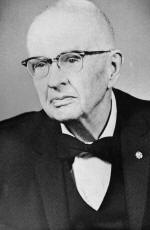Andrew W. and Roscoe C. Iddings
Andrew and Roscoe Iddings had roots in the Dayton area that dated to the early 1800's. One of the early homes of the Iddings family is a log cabin located outside Troy, Ohio, at the Brukner Nature Center. The Foundation has supported the renovation and upkeep of the historical building that is used with school groups for a look at pioneer life.
Their grandfather, Daniel, was born in Dayton in 1819 and attended Miami University in 1838. He worked as an attorney, specializing in corporate law. He also helped to develop early fire insurance policies and organized The Montgomery County Fire Insurance Company in 1840. Their father, Charles, followed the family tradition as a practicing lawyer in Dayton.
Andrew and his older brother, Daniel, became third generation attorneys and founded their first law firm, D. W. and A. S. Iddings, in the early 1900's. Mostly a self-taught lawyer, Andrew did claim the Ohio State University as his alma mater. Later, Harry P. Jeffrey became an associate in the law firm and served as counsel to the Foundation until his retirement. Eventually, the law firm became known as Iddings, Jeffrey and Donnelly, then Jeffrey, Snell, Rogers, Donnelly and Greenberg. It continues today as Rogers and Greenberg.
Though an attorney by profession, Andrew Iddings spent a great deal of time traveling. He traveled around the world three times, rode pack and horse trains inside the Arctic Circle and traversed the savannas of Africa. Sometimes his younger brother, Roscoe, joined him in these adventures. Andrew was honored by being elected a member of the Explorers Club in New York with men such as Lowell Thomas and Admiral Richard Perry. He was a fellow of the Royal Geographic Society of London.
Photography also fascinated Andrew. Beginning with his travels in 1902, he became known for his quality pictures and interesting narratives of his many trips. In 1908, Andrew was hired by Keystone View Company to be its chief of the photographic staff. For eleven years he traveled the world taking thousands of glass plate stereographic negatives which he carefully waterproofed, packed and shipped to Keystone He took stereopticon views of the Near East, Balkans and South America for the National Geographic Magazine for several years beginning in 1910. In 1919, Andrew was sent overseas by the U.S. Government to photograph the postwar devastation. Andrew developed the stereographic negative process which eventually led to the development of 3-D images.
Many of Andrew's photographic plates are housed in the archives at Wright State University. Among this collection is a series of pictures which records the Dayton homecoming celebration of the Wright Brothers in 1909. During the centennial of powered flight in 2003, the Carillon Historical Park compiled these photographs (the only known record of this event) into a book, which noted the Iddings Foundation with appreciation for its long-time support of the park.
Andrew and Roscoe made a grant to Miami University to construct a six foot diameter geo-physical globe, the most accurate of its time. It can be found today in the lobby of Shideler Hall.
Through the Dayton Metropolitan Housing Authority and other organizations like the Dayton Boys Club, Andrew Iddings was long considered a leader in philanthropy in the Dayton Area and left an enduring legacy. He served as President of both the Dayton Bar and Ohio State Bar Associations. Andrew spent 14 years on the City of Dayton Plan Board and also served as General Counsel and Secretary of the Board of Stillwater Tuberculosis Hospital, which was founded by his brother, Daniel. Andrew received honorary degrees form Miami University and the University of Dayton He died at the age of 94 in 1974.
Roscoe ignored the family's traditional profession, law, and instead built a strong reputation as an astute businessman. He first learned about the fire fighting business while in New York in 1909. He purchased the Ohio sales territory from the Pyrene Manufacturing Company that had patented a fire extinguisher process. From this start, he founded the Fyr-Fyter Company, which manufactured fire extinguishers in Dayton from 1916 until the company was sold in 1947. Over that period, Roscoe served as president and general manager. Under his guidance, the company grew from a small enterprise to a highly successful manufacturing company whose products were sold throughout the world. He pioneered the development of the stainless 2 1/2 gallon fire extinguisher which became world renowned.
Andrew and Roscoe took a leadership role in product sales around the world. The company supplied fire extinguishers for military use during WWI and WWII. Roscoe personally developed a number of patented improvements to the fire extinguisher and also developed and used several innovative approaches to the sale and marketing of their product.
Both Andrew and Roscoe were 33rd degree Masons. Roscoe founded and chaired one of the oldest blood bank collection points in the Dayton area, the Masonic Blood Bank. In addition to the Scottish Rite, Roscoe was also a member of the Antioch Temple and the Engineer's Club. He died at the age of 83 in 1971.


